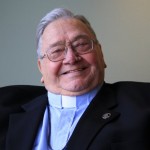Paul writes to Thessalonians
By the Rev. Canon Don Beatty
 Towards the end of his second missionary journey, Paul moved from Athens to Corinth. He would stay in and around this city for the next year and a half – his longest stay in any place during the journey.
Towards the end of his second missionary journey, Paul moved from Athens to Corinth. He would stay in and around this city for the next year and a half – his longest stay in any place during the journey.
As Paul arrived in Corinth, he met up with Priscilla and Aquila, a Jewish couple who had converted to Christianity. They had been expelled from Rome during the ethnic cleansing by the Emperor Claudius, who had ordered out all of the Jews. This expulsion happened in 48 CE, so we can date Paul’s time in Corinth to sometime after that. Priscilla and Aquila were tent makers, and Paul began working with them as well as attending the local synagogue each week. After a brief time, the Jews drove Paul from the synagogue, so he and his new friends started to convert the Gentiles there, especially the God-fearers.
Timothy and Silas caught up with Paul in Corinth. Timothy reported on the state of the church in Thessalonica. Remember, Paul was in Thessalonica for only a brief time and was concerned for the church’s welfare. The church in Thessalonica continued to grow and thrive, but it had a major problem: trying to understand the second coming of Christ. The followers were grieving their dead and felt that the deceased would miss out on this important part of their life with Christ. This was an essential doctrine for Paul and the early church, so he proceeded to write the first epistle to the Thessalonians, addressing the issue that the dead will be raised up with Christ. Here we see the beginning of Paul’s correspondence, usually addressed to churches or individuals dealing primarily with pastoral concerns. 1 and 2 Thessalonians are probably the oldest Christian literature that we possess, dating from 51-52 CE – about 20 years after the crucifixion.
These two epistles should to be read together. Some scholars believe that the second epistle may not have been written by Paul, primarily because of Paul’s response to the issue of the second coming is very different from his answer in the first letter. I think there is an easier explanation to this problem.
Let us look at Paul’s initial response to the problem of eschatology (end times). The Thessalonians’ faith and love were very strong, but their hope was lacking conviction. Paul reminded them that the end times will come “like a thief in the night.” We do not know when it will come, but we must remain vigilant. We need to live our lives as though the second coming of Jesus was imminent, always prepared to meet the Risen Christ.
This message from Paul was so strong that many Thessalonians decided to stop working and sit around waiting for the second coming of Jesus. When that message reached Paul, he wrote the second epistle, very strongly recommending that if they don’t work, they won’t eat. (See 2 Thessalonians 3:6-13.) This was a very different response, as he tried to keep them theologically correct and morally responsible. We do not know the day or the hour when Christ will return. The early church believed it was imminent, but as time passed and Jesus did not return, it became evident that the second coming was a future event, and would remain a future hope for most believers.
Paul’s concern in these letters was primarily pastoral. The Gentile Christians in Thessalonica needed to be assured that Jesus would accept all who lived and died in Christ, and that although we must always be ready to accept the risen Christ, we should not avoid living useful, productive lives.
You can read about Paul’s mission in Corinth in Acts 18. When he left this important city after one and a half years, he took Priscilla and Aquila with him across the Aegean Sea to Ephesus. Timothy and Silas may have stayed in Corinth. Aquila and Priscilla remained in Ephesus to work in building up the church in there. Paul would return to Ephesus during his third journey and would spend more than two years there.
I have often wondered if Paul’s church in Ephesus was still in existence a few years later, when John and Mary, the mother of Jesus, arrived there having fled Jerusalem during the persecutions of the late 80s or early 90s CE. It is probable that the Gospel of John was written in that city, but I can find no connection between the Pauline Church and the Johannine Church. This is an interesting question. I must do more research on the early Ephesian Church.
Next month we will look at the first council in Jerusalem, the third missionary journey, and Paul’s letter to the Corinthians. The first epistle to the Corinthians is Paul’s second longest and probably the second most important letter next to the epistle to the Romans. Enjoy the dialogue.
The Rev. Canon Don Beatty is the honorary assistant at St. Luke, Dixie South, Mississauga.